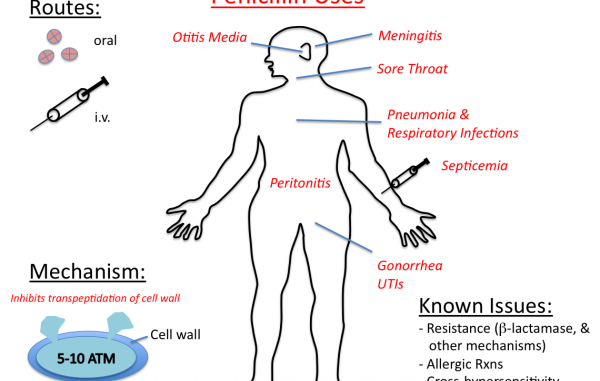
Clinical use of penicillin antibiotics
1. Penicillin G:
- Penicillin G is the drug of choice in infection caused by Pneumococci, Streptococci, Meningococci, Gonococci and Staphylococci (Non β-lactamase producing Staphylococci).
- They are effective against Spirochaetes, Bacillus anthracis and other gram positive rods, Clostridium spp and other anaerobes but inactive against Bacteroides fragillis (gram –ve rod).
- They are also active against Listeria spp and Actinomycetes.
2. Penicillin V:
- Penicillin V is used for the treatment of mild respiratory tract infection such as Pharyngitis, otitis media, sinusitis etc.
- It is oral drug.
3. Benzathine Penicillin G:
- Benzathine penicillin G is the insoluble salt of penicillin G and it is used for intramuscular injection. This is slow acting drug for prolong use.
- A single dose of 1.2 million units of benzathine penicillin G is suitable for treatment of β-hemolytic Streptococcal pharyngitis.
- 4 million units of benzathine penicillin G injected once in 1-3 weeks in an appropriate proportion measure for primary and latent Syphilis.
4. Ampicillin, Amoxycillin, Carbenicillin, Ticarcillin, azolocillin, Mezlocillin and Piperacillin:
- Ampicillin is active against coli, Salmonella, Shigella and Haemophilus influenzae but not active against indole +ve Proteus (P.vulgaris), Pseudomonas, Klebsiella and Enterobacter.
- Amphicillin and Amoxycillin are commonly used for treatment of common UTI caused by coliforms bacteria and for the treatment of mixed secondary bacterial infection of respiratory tract.
- Ampicillin was a drug of choice in meningitis caused by influenzae but now a days Ceftriazone is used because of emergence of β-lactamase producing strain of H. influenzae.
- Ampicillin and Amoxyccillin are alternative drug in typhoid fever but should not be used in non-invasive Salmonella gastroenteritis.
- Carbenicillin is active against Pseudomonas and Proteus but not against Klebsiella.
- Ticarcillin also active against Pseudomonas and proteus in lower dose than Carbenicillin.
- Azolocillin, Mezlocillin and Piperacillin have greater activities against Pseudomonas than Carbenicillin.
5. Β-lactamase resistant penicillin: Methicillin, Nafcillin, Oxacillin, Cloxacillin, Dicloxacillin
- These penicillins are used to prevent infection caused by β-lactamase producing streptococci.
- These drugs are highly protein bound therefore they consumed 1 hour before and after meals.
- Except Methicillin all β-lactamase resistant penicillin are suitable for oral administration. However methicillin is nephrotoxic and is not suitable for theurapeutic use.
6. Combination of Penicillin with β-lactamase inhibitors:
- β-lactamase inhibitors are also β-lactam group of antibiotics but with very little antimicrobial activity.
- β-lactamase inhibitors are usually used in combination with β-lactam antibiotics (penicillin) to treat infection caused by β-lactamase producing strain of bacteria.
- Commonly used β-lactamase inhibitors are; sulbactum, tazobactum and clavulanic acid.
Combination drugs commonly used are:
- Zosyn: piperacillin + tazobactum
- Unasyn: amphicillin + sulbactum
- Angmentin: amoxicillin + clavulanic acid
